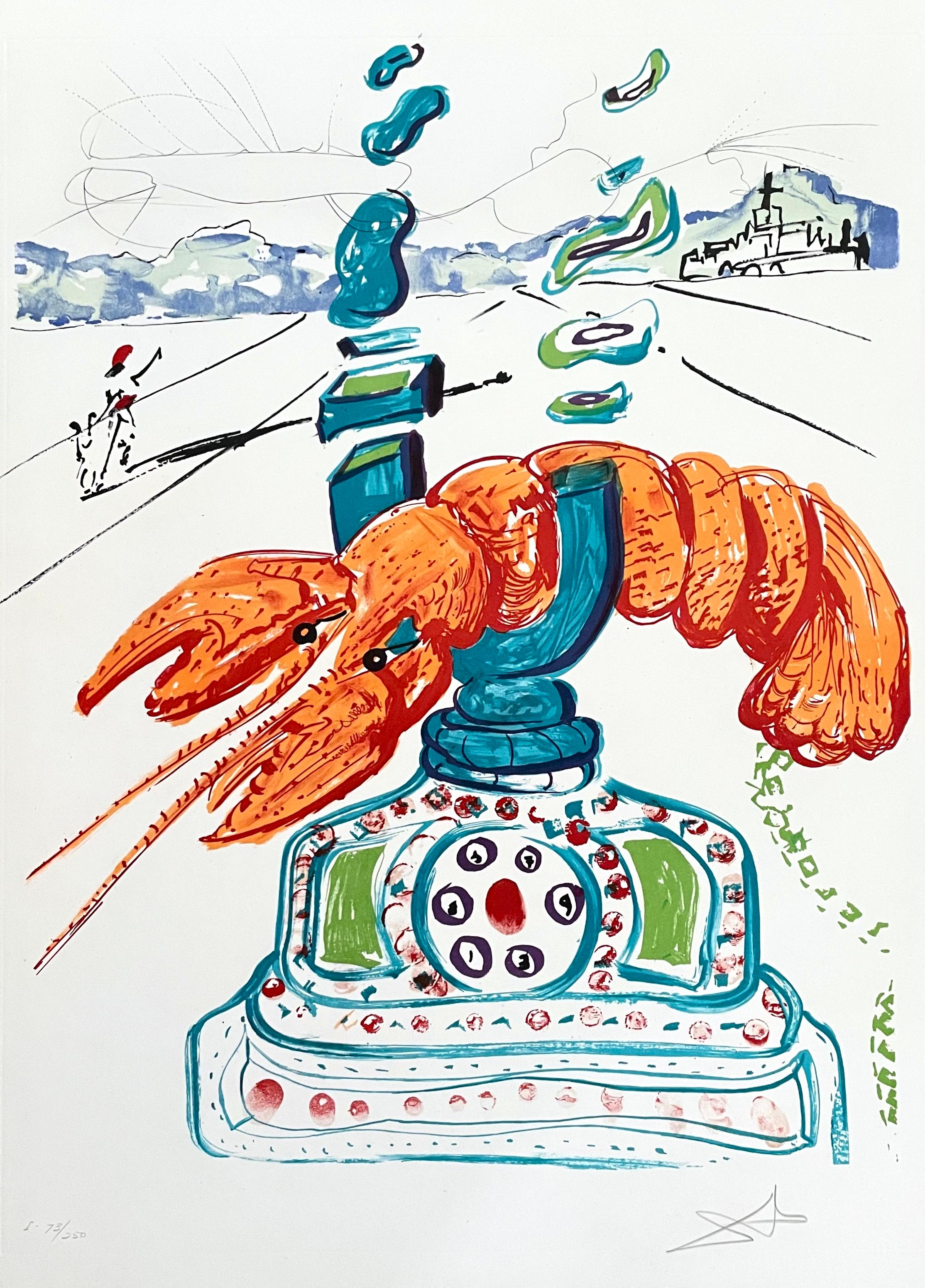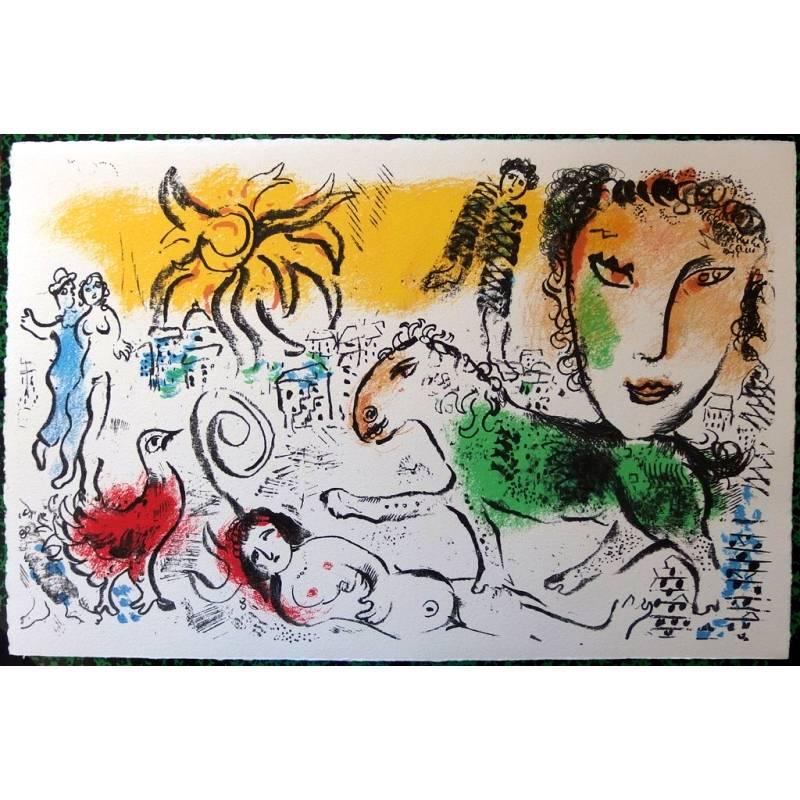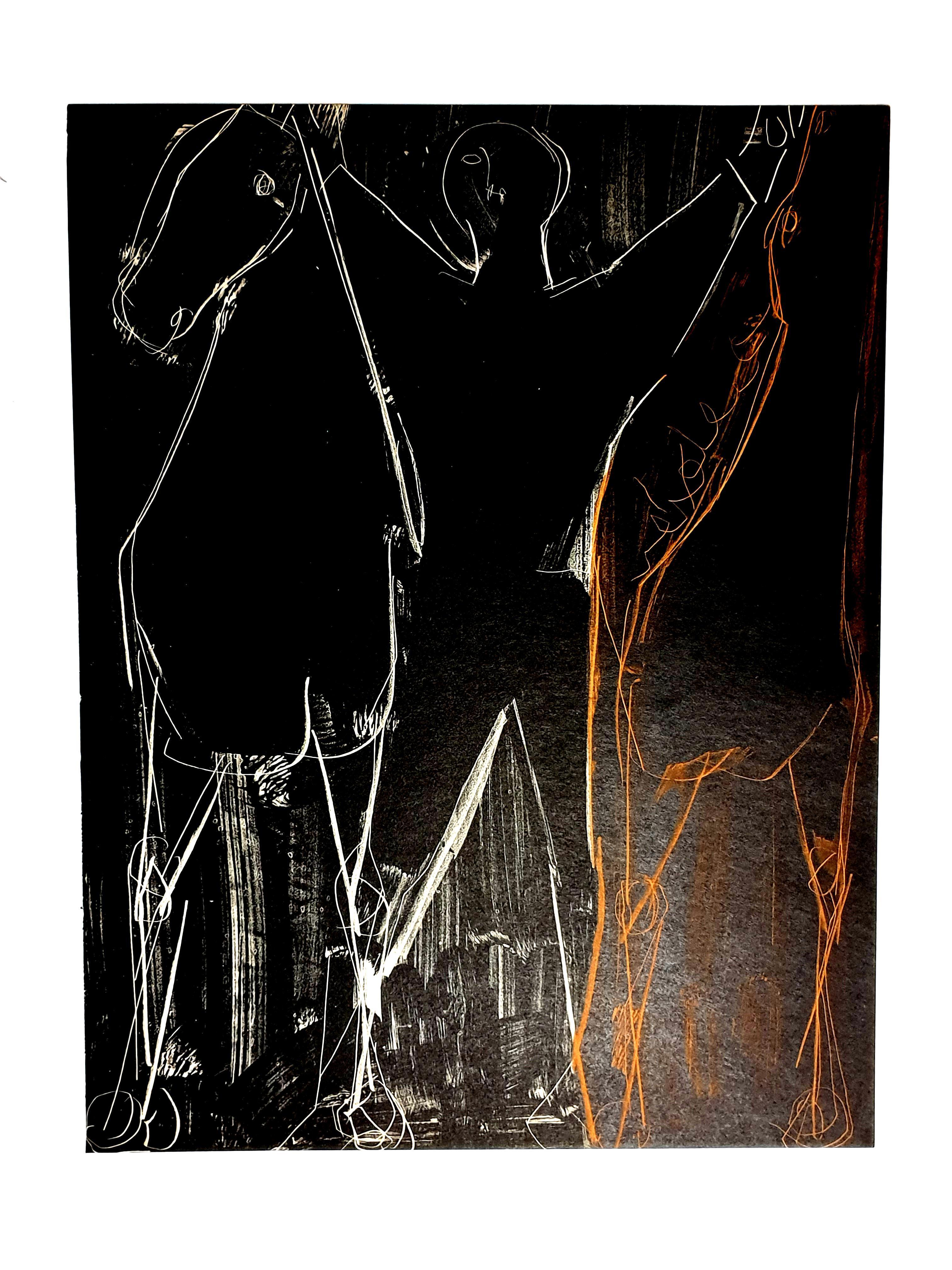Items Similar to Selbstbildnis (huendisch)
Want more images or videos?
Request additional images or videos from the seller
1 of 8
Reiner SchwarzSelbstbildnis (huendisch)1972
1972
About the Item
Reiner Schwarz
"Selbstbildnis (huendisch)"
From Portfolio "Portrait #11 - Reiner Schwarz" with Karin Szekessy
Year: 1972
Medium: Color Lithograph
Edition: 100
Size: 23.9 x 16.6 in.
Publisher: Dieter Brusberg, Hannover - Germany
Litho Printing by Reiner Schwarz, Berlin Germany
Signed, numbered and titled
After fleeing and expelling from Silesia, Reiner Schwarz spent the rest of his childhood in a village near Hanover, the essential school time then in Hanover. In 1960 he moved to Berlin, where he began studying at the State University of Fine Arts with the surrealist Mac Zimmermann .
In 1964 his work was first shown in a solo exhibition in Bremen. The criticism in Bremen attested to his own view of things, his own pictorial language, which feeds on the close observation of the environment. Gallery Brusberg represented over 20 years the entire work Reiner Schwarz ', documented with the catalog raisonné of the lithographs of 1984. Several large exhibitions, such as the Kunstverein Mannheim, the Museum Ostdeutsche Galerie Regensburg (retrospective of images and lithographs) , followed in the gallery Brusberg in Hannover and in Berlin on the Kurfürstendamm.
In 1987 there was a pioneering meeting with Rolf Münzner (Geithain) and Peter Schnürpel (Altenburg) in the printing workshop Kätelhön. 1988 Black began to draw realistically on large format packaging papers from the GDR. The chief restorer of the Staatliche Museen zu Berlin, Prussian Cultural Heritage, judges the quality of these GDR packaging papers: "They are a natural product, darken slightly, but are completely harmless in the conservatory sense." Of these packaging papers, on which Reiner Schwarz bis works today, man is gone. One experiences still lifes, objects of the everyday use and just deserted spaces - but "... they are spaces in which the people lived, left their traces and shaped the spaces. The objects became individuals in use by humans themselves, they carry the memory of these people in themselves. I pay tribute to the objects and the people I did not know that I did not represent, but who gave these things life. " The art historian Helmut Börsch-Supan wrote about these drawings:" Reiner Schwarz shows the view of reality from which man is banished and only what he has done is visible ... His message is gentle but subversive. It is resistance to the inhuman speed of the machine. The pictures argue for a different way of dealing with time and therefore also with life. "
- Creator:Reiner Schwarz (1940)
- Creation Year:1972
- Dimensions:Height: 23.9 in (60.71 cm)Width: 16.6 in (42.17 cm)
- Medium:
- Movement & Style:
- Period:
- Condition:
- Gallery Location:Kansas City, MO
- Reference Number:
About the Seller
5.0
Platinum Seller
These expertly vetted sellers are 1stDibs' most experienced sellers and are rated highest by our customers.
Established in 2016
1stDibs seller since 2017
951 sales on 1stDibs
Typical response time: <1 hour
- ShippingRetrieving quote...Ships From: Kansas City, MO
- Return PolicyA return for this item may be initiated within 10 days of delivery.
More From This SellerView All
- Les Printemps D'Uranus ChevalBy Jean-marie GuinyLocated in Kansas City, MOJean-Marie Guiny "Les Printemps D'Uranus Cheval" Lithograph Signed and numbered by the artist Edition: H.C. Size: 19.5 x 25.75 inchesCategory
Late 20th Century Contemporary Animal Prints
MaterialsLithograph
- Lithographier Originale (Les Peintures Sur Carton) (Abstract, Fun, Gestural)By Joan MiróLocated in Kansas City, MOJoan Miro Lithographier Originale (Les Peintures Sur Carton De Miro) Original Color Lithograph Year: 1965 Size: 14.5x10.5in Edition: 150 Portfolio: DLM 151-152 Publisher: Maeght Ed...Category
1960s Abstract Expressionist Abstract Prints
MaterialsLithograph
- Osage Sheep State IIBy Theodore WaddellLocated in Kansas City, MOTheodore Waddell Osage Sheep State II Year: 1994 Color Lithograph Edition: 30 Papers: Arches Cover, Black Paper Size: 22.5 x 30 inches Image Size: Same Signed and numbered by hand CO...Category
1990s Contemporary Abstract Prints
MaterialsLithograph
- Study of Two Classical Greek Horse Heads and a Modern HorseBy Luis JiménezLocated in Kansas City, MOLuis Jimenez Study of Two Classical Greek Horse Heads and a Modern Horse Year: 1994 2 Color Lithograph Edition: 28 Paper: Rives BFK, White Paper Size: 29.5 x 41 inches Image Size: 16 x 33 inches (irregular) Signed and numbered by hand COA provided --------------- Luis Alfonso Jiménez...Category
1990s Modern Animal Prints
MaterialsLithograph
- Study of a Classical Horse and a Modern HorseBy Luis JiménezLocated in Kansas City, MOLuis Jimenez Study of a Classical Horse and a Modern Horse Year: 1994 4 Color Lithograph Edition: 40 Paper: Rives BFK, White Paper Size: 41.75 x 29.5 inches Image Size: 37 x 22.75 inches Signed and numbered by hand COA provided --------------- Luis Alfonso Jiménez...Category
1990s Modern Animal Prints
MaterialsLithograph
- Lithographier Originale (Les Peintures Sur Carton) (Abstract, Fun, Gestural)By Joan MiróLocated in Kansas City, MOJoan Miro Lithographier Originale (Les Peintures Sur Carton De Miro) Original Color Lithograph Year: 1965 Size: 14.5x10.5in Edition: 150 Portfolio: DLM 151-152 Publisher: Maeght Ed...Category
1960s Abstract Expressionist Abstract Prints
MaterialsLithograph
You May Also Like
- Cybernetic Lobster Telephone (Imagination & Objects), Salvador DaliBy Salvador DalíLocated in Fairfield, CTArtist: Salvador Dali (1904-1989) Title: Cybernetic Lobster Telephone (Imagination & Objects of the Future Portfolio) Year: 1975 Medium: Lithograph ...Category
1970s Surrealist Landscape Prints
MaterialsLithograph, Mixed Media
- Marc Chagall - The Green Horse - Original LithographBy Marc ChagallLocated in Collonge Bellerive, Geneve, CHMarc Chagall Original Lithograph Title: The Green Horse 1973 Dimensions: 33 x 50 cm Reference: This lithograph was created for the portfolio "Chagall Monu...Category
1970s Surrealist Figurative Prints
MaterialsLithograph
- Jean Arp - Original LithographBy Jean ArpLocated in Collonge Bellerive, Geneve, CHJean Arp - Original Lithograph 1951 Dimensions: 32 x 24 cm From the art revue XXe siècle Unsigned and unumbered as issuedCategory
1950s Surrealist Animal Prints
MaterialsLithograph
- Marino Marini - Horses - Original LithographBy Marino MariniLocated in Collonge Bellerive, Geneve, CHMarino Marini - Horses - Original Lithograph 1951 Dimensions: 32 x 24 cm From the art review XXe siècle Unsigned and unumbered as issuedCategory
1950s Surrealist Animal Prints
MaterialsLithograph
- Max Ernst - Elektra - LithographBy Max ErnstLocated in Collonge Bellerive, Geneve, CHMax Ernst - Elektra Lithograph 1939 Dimensions: 32 x 24 cm Signed in the plate From XXe siècle Unsigned and unumbered as issuedCategory
1930s Surrealist Animal Prints
MaterialsLithograph
- Max Ernst - Composition - Original LithographBy Max ErnstLocated in Collonge Bellerive, Geneve, CHMax Ernst - Composition - Original Lithograph 1958 Dimensions: 32 x 24 cm XXe siècle Unsigned and unnumbered, as issued Max Ernst was born in Bruhl, a place near Cologne, in Germany. He was raised in a strict Catholic family, and both of his parents were disciplinarians who were dedicated to training their children into God-fearing and talented individuals. Although his father was deaf, Ernst learned so much from him, particularly when it comes to painting. In fact, much of his early years were lived under the inspiration of his father who was also a teacher. He was the one who introduced painting to Ernst at an early age. In 1914, Ernst attended the University of Bonn where he studied philosophy. However, he eventually dropped out of school because he was more interested in the arts. He claimed that his primary sources of interest included anything that had something to do with painting. Moreover, he became fascinated with psychology, among other subjects in school. Primarily, Ernst's love for painting was the main reason why he became deeply interested with this craft and decided to pursue it later on in his life. During his early years, he became familiar with the works of some of the greatest artists of all time including Claude Monet, Paul Cezanne and Vincent van Gogh. He was also drawn to themes such as fantasy and dream imagery, which were among the common subjects of the works of Giorgio de Chirico. During World War I, Ernst was forced to join the German Army, and he became a part of the artillery division that exposed him greatly to the drama of warfare. A soldier in the War, Ernst emerged deeply traumatized and highly critical of western culture. These charged sentiments directly fed into his vision of the modern world as irrational, an idea that became the basis of his artwork. Ernst's artistic vision, along with his humor and verve come through strongly in his Dada and Surrealists works; Ernst was a pioneer of both movements. It was Ernst's memories of the war and his childhood that helps him create absurd, yet interesting scenes in his artworks. Soon, he took his passion for the arts seriously when he returned to Germany after the war. With Jean Arp, a poet and artist, Ernst formed a group for artists in Cologne. He also developed a close relationship with fellow artists in Paris who propagated Avant-Garde artworks. In 1919, Ernst started creating some of his first collages, where he made use of various materials including illustrated catalogs and some manuals that produced a somewhat futuristic image. His unique masterpieces allowed Ernst to create his very own world of dreams and fantasy, which eventually helped heal his personal issues and trauma. In addition to painting and creating collages, Ernst also edited some journals. He also made a few sculptures that were rather queer in appearance. In 1920s, influenced by the writings of psychologist Sigmund Freud, the literary, intellectual, and artistic movement called Surrealism sought a revolution against the constraints of the rational mind; and by extension, they saw the rules of a society as oppressive. Surrealism also embraces a Marxist ideology that demands an orthodox approach to history as a product of the material interaction of collective interests, and many renown Surrealism artists later on became 20th century Counterculture symbols such as Marxist Che Guevara. In 1922 Ernst moved to Paris, where the surrealists were gathering around Andre Breton. In 1923 Ernst finished Men Shall Know Nothing of This, known as the first Surrealist painting. Ernst was one of the first artists who apply The Interpretation of Dreams by Freud to investigate his deep psyche in order to explore the source of his own creativity. While turning inwards unto himself, Ernst was also tapping into the universal unconscious with its common dream imagery. Despite his strange styles, Ernst gained quite a reputation that earned him some followers throughout his life. He even helped shape the trend of American art during the mid-century, thanks to his brilliant and extraordinary ideas that were unlike those of other artists during his time. Ernst also became friends with Peggy Guggenheim, which inspired him to develop close ties with the abstract expressionists. When Ernst lived in Sedona, he became deeply fascinated with the Southwest Native American navajo art. In fact, the technique used in this artwork inspired him and paved the way for him to create paintings that depicted this style. Thus, Ernst became a main figure of this art technique, including the rituals and spiritual traditions included in this form of art. Pollock, aside from the other younger generations of abstract expressionists, was also inspired by sand painting of the Southwest...Category
1960s Surrealist Animal Prints
MaterialsLithograph
Recently Viewed
View AllMore Ways To Browse
Study In Colour Berlin School
Prussian Prints
Bis Vintage
Gdr German
Peter Mac
Peter Dieter
Karin Szekessy
Reiner Schwarz On Sale
Mothers Day Vintage
Pop Art Lithographs 1960s
Modernist Lithograph
Henri Matisse Original
Poster Dress
Bottle Prints
Spain 1stdibs
Japanese 1960s Painting
Japanese Painting 1960s
Vintage Antique Art Prints





